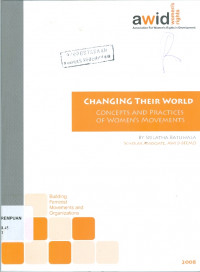
Text
Changing their world: concepts and practices of women's movements ( Building Feminist Movements and Organizations)
the book is an initiative to advance our understanding of feminist movements in the current global context, and to apply that understanding to strengthening the capacity of women's organizations to better catalyze, support, and sustain movement building.This compilation of case studies highlights the origins, structures, strategies, and impacts of various women's movements around the world. We undertook a series of 14 case studies from different regions of the world that have mobilized women to make a difference. The case studies are not a full representation of current women’s movements but rather an initial effort to document an interesting variety of movement experiences. The case studies were undertaken by researchers and advisors in different regions. A case guideline was developed to broadly obtain comparative data on the origins, structures, strategies and impacts of the movements. The studies were conducted and documented between July 2007 and February 2008. This compilation of case studies highlights the origins, structures, strategies, and impacts of various women's movements around the world. We undertook a series of 14 case studies from different regions of the world that have mobilized women to make a difference. The case studies are not a full representation of current women’s movements but rather an initial effort to document an interesting variety of movement experiences. The case studies were undertaken by researchers and advisors in different regions. A case guideline was developed to broadly obtain comparative data on the origins, structures, strategies and impacts of the movements. The studies were conducted and documented between July 2007 and February 2008. First, we wanted to clarify our concept of movements, and especially of feminist movements. This seemed critical at a time when the term “movement” was being used very loosely, to describe virtually any collective endeavor by organizations and or individuals. We believed this was partly a product of the general de-politicization and cooption of social change and feminist language after they entered the development mainstream, similar to the way terms like empowerment and rights had been divested of their once-powerful meaning. We therefore thought it was important to restore both conceptual and political clarity by re-defining movements and tackling several related questions about them. For instance, what actually distinguishes movements from other kinds of collectives, networks, and campaigns? What is the difference between an organization and a movement? What are their roles and relationships with each other? And what distinguishes feminist movements from other social movements? All these questions were addressed and clarified in chapter one, “Clarifying Our Concepts”. Secondly, we felt it was important to analyze the experiences of strong and vibrant women’s movements in different parts of the world, and understand how they evolved, strategized, and made an impact. We also wanted to explore the meaning and essence of feminist practice in movement building, and what feminist movements actually look like and how they act on the ground. We hoped such analysis would help us create a new conceptual framework that explicitly links organizational strengthening processes to movement building, from a feminist perspective. So through 2007, the BFEMO initiative undertook ten
Availability
| KP.Ii-00069-2 | KP.II BAT c | My Library | Available |
| KP.II-00069-1 | KP.II BAT c | My Library | Available |
Detail Information
- Series Title
-
-
- Call Number
-
KP.II.BAT c
- Publisher
- New Delhi : Association for Women's Rights in Development (AWID)., 2008
- Collation
-
68 Hal.;illus.; 28cm.
- Language
-
English
- ISBN/ISSN
-
-
- Classification
-
KP.II
- Content Type
-
-
- Media Type
-
-
- Carrier Type
-
-
- Edition
-
-
- Subject(s)
- Specific Detail Info
-
-
- Statement of Responsibility
-
-
Other version/related
No other version available
File Attachment
Comments
You must be logged in to post a comment
 Computer Science, Information & General Works
Computer Science, Information & General Works  Philosophy & Psychology
Philosophy & Psychology  Religion
Religion  Social Sciences
Social Sciences  Language
Language  Pure Science
Pure Science  Applied Sciences
Applied Sciences  Art & Recreation
Art & Recreation  Literature
Literature  History & Geography
History & Geography